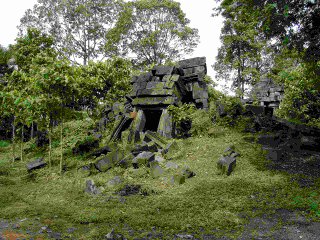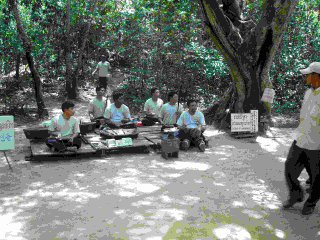




First the pictures:
a. Angkor Wat courtesy of GoogleEarth. This gives you some idea of the scale.
b. Angkor Wat from the air, photo taken from an early morning balloon flight.
c. An abandoned temple.
d. Landmine victims making money other than by begging. These groups are all over the area. Give them a $1.
e. A group of hopeful tourists looking at sunset over AW. As with many sunrise/set events this was not as great as promised (however, to be fair, on those two or three days a year when environmental factors are right it is spectacular—so I am told).
Understanding the AW Temple setup:
Overall, there are approximately one hundred structures scattered over the AW Temple area, which begins approximately six kilometres north of Siem Reap. I suspect that there are still many other buildings, covered by jungle, waiting to be uncovered. Many of these are small, in a poor state of repair, and rarely visited by tourists. The hoards of tourists who daily descend upon AW head in the main towards three main complexes of ancient buildings.
The eponymous and most well known of these is Angkor Wat. Without doubt (at least to me) it is the most imposing temple, though not the largest structure. It was built to reflect the structure of the universe with continents, oceans and the heavens. In essence there is a central temple, with three levels, surrounded by a square with open galleries upon whose walls are engraved bas-reliefs of religious and political events. Surrounding the central building is a series of walls and entrance ways. In practice it was a giant showroom for the kings and aristocrats. During ceremonial occasions the people would gather around the temple—but not inside—to gaze upon the nobles as they marched in procession to worship the gods. This custom of course also reinforced the existing political structure. It was built by Suryavarman II (c. 1112–52 AD).
Three kilometres to the north of AW is the second structure of tourist note, Angkor Thom. This is a stone city, encompassed by large and imposing (but no longer effective) walls. This city was built by the great Jayavarman 7th. At the centre of this now abandoned city is the Bayon Wat. On the eastern perimeter of Angkor Thom is the ‘Terrace of Elephants’, from this highpoint, no doubt on top of a large wooden review stand which no longer exists, J the 7th reviewed his troops and people. Also part of Angkor Thom is an interesting structure, the ‘Terrace of the Leper Kings’. This is a platform, upon which sit an enigmatic statue, surrounded by religious carvings. The statue is near unique in that it depicts a figure with leprosy. It is a universal given that the gods are perfect (with a few exceptions, Hephaestus for example), but here is a god with leprosy! The statue may represent Yama, the god of death, or a Khmer ruler Yasovarman, who, it is believed, died of leprosy.
The third structure is Ta Prohm. It lies three kilometres to the east of Bayon. This Wat is famous because, as every 2nd person in SR will tell you, it was used as a set in the first (and better) Tomb Raider movie. Its principal and readily visible claim to fame is the numerous number of trees and other foliage which have grown in and through the entire building. Inside the temple are rooms, passage ways, and open areas, all looking a little unstable. This is the temple built for the mother of J the 7th. On the first day I saw this temple it was crowded with tourists.
An interesting aspect of these temples is their pluralistic nature. They were/are used for both Hinduism and Buddhism. Originally, the temples were Hindu, but then they were converted to Buddhism. There are signs that some of the religious artwork was vandalised due to differences in religious opinion. Religion! Also, less spiritually, but just as annoying, there are a number of graffiti produced by previous generations of tourists.
These temples were rediscovered by the modern world in the mid to late 19th century. The first Europeans to see them were mightily impressed with the art and engineering, as well they should be, they are impressive accomplishments. There was a degree of archaelogical work carried out beginning in the late 19th C but this work was interupted by the various conflicts in the region, not the least of which was the Kymer Rouge regime. Since the 1990s tourism and archaelogical work has greatly increased. Hopefully these monumnets will be preserved for humanity as a whole and the Kymer people.
I spent a total of four days visiting these and other temples. I will say that I was impressed. They are impressive, imposing and certainly worth seeing. I would recommend to any traveller. I would also recommend the one week AW pass (1 day pass $20, 3 days $40, 1 week $60—too cheap imho), take your time, come back and enjoy.
Comments